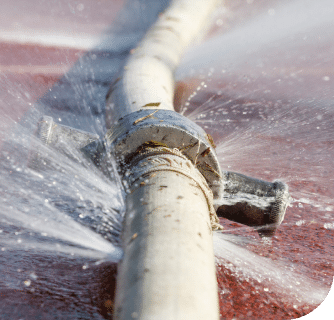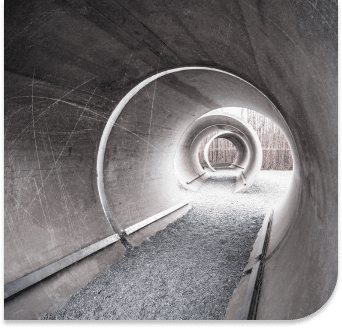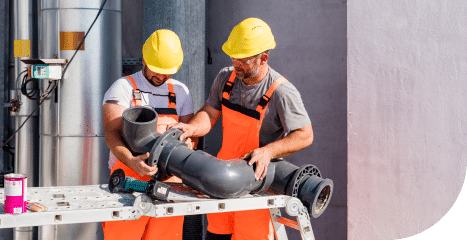Asbestos in Pipes
Asbestos is a toxic substance that was widely used in pipes and pipe insulation from the 1930s until the late 1970s. Consequently, pipefitters and plumbers were among the highest-risk occupations for developing mesothelioma. Unfortunately, workers continue to encounter asbestos today because asbestos piping can still be found in homes, industrial settings, commercial buildings, and infrastructure.
Home » National Mesothelioma Law Firm » Asbestos Exposure » Asbestos in Consumer Products and Materials » Asbestos in Pipes
How was asbestos used in pipes?
Occupations Exposed to Asbestos in Pipes
How are people exposed to asbestos in pipes?
How can I determine whether a pipe contains asbestos?
What should I do if a pipe contains asbestos?
How does asbestos exposure from pipes affect health?
Companies That Have Exposed Workers to Asbestos in Pipes
Asbestos added strength and durability to pipes and provided effective thermal insulation leak protection. It could withstand temperature extremes and harsh chemicals, and it was flexible enough to be woven into fabric and paper insulation.
Asbestos in pipes can be inhaled or ingested when damaged. The human body cannot break down or expel microscopic fibers. As a result, millions of fibers become embedded in bodily tissues, causing inflammation and ultimately leading to mesothelioma, lung cancer, and asbestosis.
How was asbestos used in pipes?
Asbestos was used in the pipe material and several piping components, including the following:
- Pipe insulation, also known as lagging or pipe wrapping
- Plaster on pipe elbows and couplings
- Pipe connection hardware, such as gaskets, valves, and flanges
Asbestos Cement Pipes
Asbestos cement pipes were commonly used for potable drinking water distribution, sewer drains, storm drains, and industrial processes. They were commonly termed transite pipes. Transite was originally a brand name for asbestos cement patented and manufactured by Johns Manville. Due to its popularity, it became a household name that referred to all asbestos cement pipes.
Asbestos cement pipes were lightweight and easy to install. They had the following advantages:
- Long lifespan
- Resistance to corrosion
- Resistance to pests
- Soundproof qualities
Asbestos Cement Water Pipes
An estimated 18 percent of water distribution pipes in the United States and Canada are made of asbestos cement, according to the Fresh Outlook Foundation, an environmental organization. It became so popular that cement pipe manufacturer Eternit boasted that by 1948, it had sold a quantity of pipes that equaled two and half times the earth’s circumference.
Asbestos cement pipes contained up to 20 percent asbestos. When they were introduced in the United States in the 1930s, manufacturers promoted them as being incapable of deterioration. This turned out to be false. Not only do they deteriorate, but they break with age.

Are asbestos cement water pipes still used today?
Due to the extensive use of asbestos cement pipes, they can still be found in older homes and drinking water systems. In homes, these pipes are often located under slabs and can be difficult to access for repair or replacement. In infrastructure, they are often located under bridges and roads.
Phoenix is the last major city to use asbestos cement pipes in the municipal water system. As of 1994, the city was still using it and repairing it with new asbestos cement pipe that had to be imported from Mexico.
According to American Abatement, an asbestos abatement contractor in the Phoenix area, the city of Phoenix and the surrounding areas are replacing the asbestos cement water pipes with other materials in conjunction with road improvements. However, many public works water pipes in Phoenix are still asbestos cement pipes.
Industrial Asbestos Cement Pipes
Asbestos cement pipes are non-conductive to electricity in addition to being non-corrosive, soundproof, and chemically inert. They are useful for transporting water, gasses, and other products. Common industrial uses for asbestos cement pipe include the following, according to Ellis Environmental Management, Inc.:
- Conduit lines for electrical and telecommunications wiring
- High-pressure freshwater lines
- Sewer lines that move water from homes to wastewater treatment plants

Asbestos in Steel Pipes
Asbestos steel pipes may contain up to 15 percent asbestos, according to Asbestos 123, an asbestos testing company. Asbestos was used in steel pipes to reduce their conductivity and increase their safety in areas prone to static charges. Asbestos steel pipes were commonly used to move liquids under high pressure.
Asbestos Pipe Insulation
Asbestos was also heavily used in pipe insulation due to its high thermal value and resistance to fire, heat, moisture, electricity, and chemicals. It insulated hot water pipes and prevented condensation on cold water pipes. It was extensively used in homes, factories, industrial settings, and ships. It may be found in conjunction with the following:
- Boilers
- Water heaters
- Steam-heating pipes
Insulated pipes can be found in crawl spaces, hallways, and chase ways. It may be found in boiler rooms and engine rooms aboard ships and in factories, power plants, oil refineries, and steam engines.
The mere presence of asbestos pipe wrap does not mean the asbestos is airborne. It becomes airborne when it is disturbed. Asbestos is often categorized according to how easily this may occur.

- Non-friable asbestos cannot be disturbed easily with hand pressure alone. It requires mechanical destruction of the material in which it is encased, such as cutting, drilling, or sanding.
- Friable asbestos can be easily disturbed with hand pressure, even by merely touching it. Some friable asbestos is so delicate that a slamming door, burst of air, or chronic vibration is sufficient to disturb it. Friable asbestos is more hazardous because of its increased likelihood of being disturbed.
Asbestos pipe wrap was applied as a prefabricated wrap, plaster mud, or spray. The prefabricated wrapping typically resembled white corrugated cardboard. All three forms were friable.
Some pipe insulation is comprised of paper or felt, which is sometimes non-friable. These forms typically have high asbestos content. Insulation materials for steel pipes may be pure asbestos.
The EPA banned prefabricated and spray-on asbestos pipe insulation in 1973. However, it was prevalent before this time, and houses built prior to 1973 may still have asbestos pipe insulation. This is also true of industrial settings, where equipment and hardware are often older.
Pipe Connectors
Pipes are often combined to form complex pathways and networks between points where liquids, gasses, and electrical lines are transported. This can involve a series of elbows and flanges between stations or destination points. Valves and other fittings are also needed to facilitate the removal of products from pipes.
When liquids or gasses are transported in pipes, the potential for leaks is highest at the connection points. Gaskets, packings, and fittings were used to create airtight and watertight seals at these points.
Asbestos strengthened the gaskets, packings, and fittings, increased their resistance to heat and chemicals, and improved their anti-leak qualities. This was especially important in pipes that carried pressurized substances or in extreme temperature situations.
Asbestos was also a common ingredient in adhesives, which were often used at these connection points in conjunction with flanges, elbows, and valves. Adhesives in pipes may include the following, any of which likely contained asbestos:
- Plumbers’ putty
- Pipe joint compound
- Primer
- Cement
- Glue
- Teflon tape
Asbestos in PVC Pipes
Polyvinyl chloride pipes, more commonly known as PVC pipes, are generally regarded as a safe alternative to asbestos cement pipes. However, they may contain asbestos because chlorine is an essential ingredient in manufacturing PVC.
According to Toxic-Free Future, an environmental organization, approximately 18 percent of the nation’s chlorine is still made using asbestos diaphragms. Asbestos can leach into chlorine and, ultimately, PVC pipes.

Occupations Exposed to Asbestos in Pipes
The occupations experiencing the heaviest exposure to asbestos in pipes are plumbers and pipefitters. These workers have similar responsibilities but work with different materials. Plumbers are likely to encounter asbestos in pipe insulation and cement asbestos water pipes.
Pipefitters and steamfitters install and maintain pipes in industrial, manufacturing, and commercial settings where pipes carry gasses, chemicals, and acids. Fitters work directly with asbestos-containing gaskets, valves, and flanges. They may also encounter asbestos cement pipes. They are more likely than plumbers to work with steel pipes, which may be insulated with 100 percent asbestos insulation.
Plumbers and pipefitters are not the only workers that experience occupational asbestos exposure from pipes. Workers in manufacturing, maintenance, and construction fields may also be exposed, including the following:
- Construction workers
- Maintenance workers
- Millwrights
- Engineers
- Shipyard workers
- Factory workers
- Boiler workers
- Furnace workers
- Building inspectors
- Electricians
- Insulators
- Oil refinery workers
- Carpenters
- U.S. Navy veterans
- Coast Guard veterans
How are people exposed to asbestos in pipes?
People can be exposed to asbestos in pipes through their occupations, do-it-yourself projects at home, or drinking water supplied by asbestos cement water pipes.
Asbestos in Drinking Water
The U.S. Environmental Protection Agency (EPA) published a report in 1979 that discussed the potential of asbestos from cement pipes to enter the water supply. According to the report, the majority of consumers drinking water from cement pipes could be exposed to up to one million asbestos fibers per liter.
The EPA found that some residents in the Bay Area of California and the Pacific Northwest were exposed to a range of one million to 100 million fibers per liter.
Approximately 16 percent of United States utilities provided “aggressive water,” which is water that can dissolve minerals, according to the Drinking Water Foundation. This is also known as corrosive water. Customers who consume aggressive water from asbestos cement pipes were exposed to 10 million fibers per liter, according to the EPA.
The EPA currently allows seven million fibers per liter to be present in drinking water.
Asbestos Exposure in Pipes in the Workplace
Plumbers, fitters, and other workers may have initially been exposed to asbestos during the manufacture and installation of piping, pipe insulation, gaskets, flanges, and valves. While these products are no longer manufactured with asbestos, asbestos pipes are still prevalent from previous installations.
Workers can still be exposed to asbestos in pipes today while cutting, removing, or repairing the pipe. Exposure could occur during building inspections and renovations when workers merely bump into pipe insulated with the asbestos lagging, since this asbestos is friable. Removing or disturbing the lagging can release a significant amount of asbestos.
Maintenance workers and millwrights who remove gaskets, flanges, and valves from pipes on older industrial equipment, such as that found in oil refineries, boiler rooms, and large vessels, are also at risk for exposure. Electricians may be exposed when cutting asbestos cement conduit pipes, with higher exposures if they are insulated.
Construction workers may be exposed to asbestos in pipe and pipe insulation while performing renovations and demolitions. During the period when asbestos was still being applied, some construction workers may have been involved in applying the asbestos to the pipes, resulting in heavy exposure.
How can I determine whether a pipe contains asbestos?
It is impossible to confirm or rule out the presence of asbestos without completing professional testing. The most important determining factor is the age of the installation, with pipes installed before 1980 more suspicious than a newer installation. However, testing is the only way to be certain.
A few other telltale signs should also raise your suspicions. According to Inspectapedia, corrugated asbestos pipe insulation that feels like paper or fabric is likely to contain asbestos. If you see joints or irregular surfaces covered with a plaster-like paste, also known as “hard lagging,” it may contain asbestos.
According to Asbestos Sampling, asbestos pipe insulation may appear fluffy, smooth, or lumpy, like dried cement. It may even resemble built-up dust. It typically feels like paper, cardboard, or felt.
Cement water pipes installed before 1980 should be suspected of asbestos. These can be difficult to locate and remediate because they are often built into the slab of the residence.
What should I do if a pipe contains asbestos?
If you have confirmed the presence of asbestos in pipes in your home or workplace, follow the recommendations of the asbestos abatement company. If the asbestos is in friable exterior pipe insulation, it will most likely need to be removed, especially if it is in poor condition. This should only be done by a licensed asbestos abatement contractor.
In some cases, the asbestos could be encapsulated by walling off the area. However, if the pipes are used for drinking water, you will likely need to have them replaced. If removal is impractical, you may have the option to reroute your water supply through new water lines and encapsulate the cement lines.
Do not cut, drill, or repair any pipe, insulation, component, or any other product containing asbestos. If possible, avoid entry into the area until after it is remediated and the asbestos abatement company has confirmed through air quality testing that no ambient asbestos is present.
How does asbestos exposure from pipes affect health?
Asbestos in pipes may be inhaled or ingested, both of which can lead to various cancers and scarring of the lungs. While inhalation is the most common form of exposure associated with illness, several studies have found correlations between ingestion of asbestos and asbestos-related illnesses.
Ingestion of Asbestos
Ingestion of asbestos occurs when it is swallowed. This most commonly occurs when drinking water supplied by asbestos cement piping is consumed. However, anyone exposed to asbestos may swallow it. When asbestos fibers are inhaled, the body may attempt to expel them by coughing them up. In many cases, they are then swallowed.
An Italian study published by Epidemiologia e Prevenzione found correlations between asbestos in drinking water and gastrointestinal cancers, including colorectal and gastric cancers. These cases included patients with no documented history of asbestos inhalation. The Expert Review of Gastroenterology and Hepatology also found an association with cholangiocarcinoma or bile duct cancer.
Occupational Asbestos Exposure Health Effects
The U.S. Department of Labor classifies plumbers, pipefitters, and steamfitters as one of the highest-risk occupations for developing malignant mesothelioma. Their mortality ratio compared to other trades places them in fourth place, behind only insulation, marine, and lay-out workers.
A study of plumbers and pipefitters published in the Journal of Occupational Medicine found bilateral pleural thickening in 18.3 percent of the 153 workers studied. Pleural thickening is associated with asbestos exposure and often co-occurs with mesothelioma and asbestos lung cancer.
Companies That Have Exposed Workers to Asbestos in Pipes
The following asbestos companies have manufactured, imported, or supplied asbestos pipe or asbestos-containing components for pipes, including pipe wraps, gaskets, flanges, and valves:
- Armstrong World Industries
- Eagle-Picher Industries
- Keasbey and Mattison
- Pittsburgh Corning Corporation
- Unarco Industries
- Capco Pipe Company
- Certainteed Corp.
- Crown Cork & Seal Company
- Flintkote
- Haveg Pipe Company
- Owens Corning Fiberglass Corporation/Owens-Illinois
- Plibrico Company
- Garlock Sealing Technologies
- Lamons Gasket Company
- J-M Manufacturing Company
- Johns Manville
- Beazer East, Inc.
- York-Shipley Global
- Honeywell International
- The Dow Chemical Company
- U.S. Steel
These companies may be liable for the devastating illnesses that result.
Legal Options for Asbestos Exposure in Pipes
If you have been diagnosed with an asbestos-related illness as a result of asbestos exposure in drinking water or occupational exposure to pipes, wrapping, or other pipe components, you may be eligible to file a mesothelioma claim or multiple claims for financial compensation.
Several companies that manufactured and supplied asbestos pipe and related components were overtaken by their asbestos liabilities. In response, they reorganized under Chapter 11 bankruptcy and established asbestos trust funds in compliance with the U.S. Bankruptcy Code. These companies include the following:
- Armstrong World Industries
- Eagle-Picher Industries
- Flintkote
- Garlock Sealing Technologies
- Johns Manville
- Owens-Corning Fiberglass Corporation/Owens-Illinois
- Pittsburgh Corning Corporation
- Plibrico Company
If any of these companies caused or contributed to your asbestos exposure, you may be eligible to file an asbestos trust fund claim.
If the companies that caused or contributed to your asbestos exposure are solvent, you may be entitled to pursue damages through a mesothelioma lawsuit.
Do I need a mesothelioma lawyer?
Pursuing damages in an asbestos exposure claim requires the assistance of a mesothelioma lawyer with experience handling these types of claims. Mesothelioma cases require knowledge about the history of asbestos companies, the products that contain asbestos, the health effects, and the complex legalities in each jurisdiction.
The mesothelioma lawyers at The Lanier Law Firm have been helping clients with asbestos-related illnesses win substantial verdicts and settlements for more than 30 years. During that time, we have built an extensive database of asbestos products, gathered incriminating internal asbestos company documents, and developed relationships with leading asbestos scientists and historians.
These resources help us identify your sources of exposure and give us an edge in settlement negotiations and court. Our mesothelioma lawyers understand what it takes to win the compensation you need and deserve. We refuse to stop fighting until you get justice. Contact us today for a free consultation.

By submitting this form, you agree to our terms & conditions. Please read the full disclaimer



